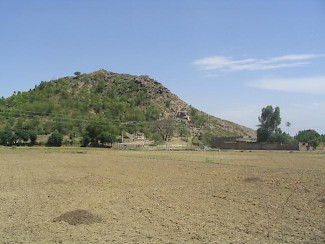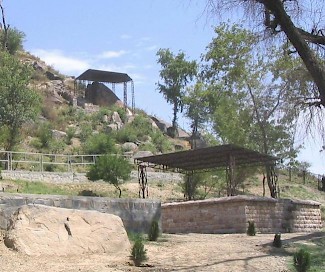Shahbazgarhi
Q7461477Shahbazgarhi: town in Pakistan, known for one of the rock edicts of the Mauryan emperor Ashoka.

An ancient traveler leaving Taxila, crossing the Indus at Hund, and traveling along the Uttarapatha, "the upper road", to the west, to Iran or Bactria, would arrive in the valley of the river Cophen and pass along Shahbazgarhi. In the legends of ancient India, this site was connected to the stories about Buddha's earlier birth as prince Visvantre.
Over here, where many travelers would rest, the Mauryan emperor Ashoka (269-232), who had conquered almost the entire subcontinent and had converted to Buddhism, ordered several rock edicts to be cut in stone. Everyone arriving from the west would understand the laws of his empire, and everybody arriving from the east would be reminded of the nobility of his ruler. This was not unique; Ashoka's edicts are known from about forty places. At Shahbazgarhi, they are cut in two large rocks, one on the slope of the hill, and one in the valley.

The largest rock contains the text of thirteen edicts, incised on both faces of that large boulder. (On other sites, a fourteenth edict is included.) The main purpose of the edicts was to establish dhamma, justice. However, the king asks: what constitutes dhamma? He answers that it includes much good and little evil, kindness, generosity, truthfulness, purity, and is explicit that "a dialog between different religions is good".
The large rock of Shahbazgarhi. The general gist of the edicts is:
- prohibition of needless killing and sacrificing of animals;
- provision of health facilities for humans and animals;
- digging of wells;
- prohibition of anti-social religious festivals;
- other aspects of good behavior, including an adhortation to the various religions to engage in a dialog;
- obedience to parents.
The full text can be read here.
The inscriptions were written in the kharoshthi-alphabet, which was, during the Persian occupation of the Punjab, derived from the Aramaic script. Elsewhere, other scripts were used. In the far west, in the town that is now called Kandahar, an edict was written in Greek. This suggests that Ashoka was very serious about his call for justice. He claims to have send missionaries to several parts of the world, including the rulers in the far west: Antiochus II Theos of the Seleucid Empire (261-246), Ptolemy II Philadelphus of Ptolemaic Egypt (282-246), king Antigonus II Gonatas of Macedonia (283-239), king Magas of Cyrenaica (275-250/249) and king Alexander of Epirus (272-258).
The smaller boulder at Shahbazgarhi contains the text of twelve edicts. Ashoka said:
This dhamma edict has been written on stone so that it might endure long and that future generations may act in conformity with it.note
 Shahbazgarhi, Large edict |
 Shahbazgarhi, Large edict |
 Shahbazgarhi, Large edict, detail |
 Shahbazgarhi, Small edict |